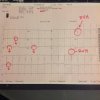I haven't seen too much data for 12 lead EKG's while using AAS. I thought it would be cool to show and tell.

12-lead EKG findings.
What's up everyone. I'll try to summarize this as well as I can without boring you or going into too much detail.
I decided to get a "12 lead" picture of my heart today. I was having chest pain and curious as to how AAS effects the heart on an acute level. Clearly, I'm no cardiologist, however, I do have a good understanding of pathophysiology and basic 12 lead EKG interpretation.
First, I will say that I do not have my old-prior EKG to compare this to but I do know that nothing was remarkable and was normal at the time of my last EKG (approx 4 months ago)
So, today at work, I was having a little substernal chest pain and wanted to run an EKG.
Here were the first findings.
I'll try not to butcher this too much. And if anyone has anything to add, please chime in.
And remember, EKG's can tell you an infinite amount of data if you're awesome at interpreting them. Again, I only have a little more than a basic understanding.
1. The red circles in leads II, III and aVF with the down sloping arrows are "T waves" which represent the repolarization or recovery of the ventricles of the heart. In most cases they're supposed to point upwards.
Inverted T waves can be many things; Pulmonary embolism, Miocardial Infarction, ischemia, amongst many other things. In this case it was peculiar because I was having chest pain at the time of the test.
2. "RVH" the circle with RVH is "Right Ventricular Hypertrophy" see how those long spikes called the "QRS" interval are peaked really high and go into the other ones above it?
The heart is a muscle, AAS increases the size of the heart as well. RVH is a sign of the heart growing, to meet the oxygen demands of the body. We all know, the right side of the heart is where it receives blood from the body via superior and inferior vena cava. In conclusion, the right side of my heart has grown bigger. Now, this is a common finding umongst lots of athletes or very active people. Nothing of too much concern.
However, I did NOT have this finding on my previous EKG months ago. I would absolutely attribute it to AAS use only because of the acute changes which differ from my previous EKG. Also, it will go down when I stop using AAS, hopefully.
In conclusion, t-wave inversion is suspect of a lot of things, but unlikely in this case since the rest of the EKG was normal. I could go into abnormal in more depth, but I fear this is boring everyone enough.
The RVH? Personally, I thinks it's pretty fucking cool to see my heart grow, also scary but interesting....very interesting.

12-lead EKG findings.
What's up everyone. I'll try to summarize this as well as I can without boring you or going into too much detail.
I decided to get a "12 lead" picture of my heart today. I was having chest pain and curious as to how AAS effects the heart on an acute level. Clearly, I'm no cardiologist, however, I do have a good understanding of pathophysiology and basic 12 lead EKG interpretation.
First, I will say that I do not have my old-prior EKG to compare this to but I do know that nothing was remarkable and was normal at the time of my last EKG (approx 4 months ago)
So, today at work, I was having a little substernal chest pain and wanted to run an EKG.
Here were the first findings.
I'll try not to butcher this too much. And if anyone has anything to add, please chime in.
And remember, EKG's can tell you an infinite amount of data if you're awesome at interpreting them. Again, I only have a little more than a basic understanding.
1. The red circles in leads II, III and aVF with the down sloping arrows are "T waves" which represent the repolarization or recovery of the ventricles of the heart. In most cases they're supposed to point upwards.
Inverted T waves can be many things; Pulmonary embolism, Miocardial Infarction, ischemia, amongst many other things. In this case it was peculiar because I was having chest pain at the time of the test.
2. "RVH" the circle with RVH is "Right Ventricular Hypertrophy" see how those long spikes called the "QRS" interval are peaked really high and go into the other ones above it?
The heart is a muscle, AAS increases the size of the heart as well. RVH is a sign of the heart growing, to meet the oxygen demands of the body. We all know, the right side of the heart is where it receives blood from the body via superior and inferior vena cava. In conclusion, the right side of my heart has grown bigger. Now, this is a common finding umongst lots of athletes or very active people. Nothing of too much concern.
However, I did NOT have this finding on my previous EKG months ago. I would absolutely attribute it to AAS use only because of the acute changes which differ from my previous EKG. Also, it will go down when I stop using AAS, hopefully.
In conclusion, t-wave inversion is suspect of a lot of things, but unlikely in this case since the rest of the EKG was normal. I could go into abnormal in more depth, but I fear this is boring everyone enough.
The RVH? Personally, I thinks it's pretty fucking cool to see my heart grow, also scary but interesting....very interesting.

